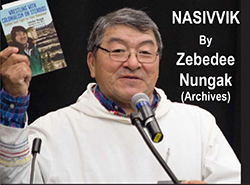
NASIVVIK By Zebedee Nungak,
Windseaker Columnist; Archives 2006
Nasivvik is an Inuktitut word that means vantage point. It can be a height of land, a hummock of ice, or any place of elevation that affords observers a clear view of their surroundings to make good observations.
Open the pages of any Arctic book or journal and the tortured spellings of Inuit names leap out like bad captions in a foreign language movie. To an Inuk reader, coming across such names in print is like having to negotiate, with great care and caution, through patches of brittle, treacherous, unavoidable rough ice.
Qallunaat [White people] have never been very successful in accurately recording Inuit names. The resulting phenomenon has often been called phonetic butchery. It exists even today, but was dismally pronounced in the earliest contacts between Inuit and Qallunaat. That is, in the infrequent cases where Qallunaat even bothered to record Inuit as individuals with names.
On the second of three journeys to Baffin Island in 1577, Englishman Martin Frobisher kidnapped three Inuit—a man, a woman, and a child—and brought them back to England as "trophies." The man's name was recorded as "Kalicho." I've seen an exhibit at the British Museum in London, which displayed an illustration of this hapless fellow, with his name written as "Kalitsaq."
It's often said that history cannot be revised. Here we have a case of a name of an Inuk kidnap victim ineptly revised through an exercise of nothing more than wild guessing, more than 400 years after the fact. It would be sweet revenge for the kidnappings to have the accurate name of this man clarified for history. We would need an Inuit Bureau for Names Accuracy (I.B.N.A.) to sort through piles of such cases.
In 1860, American explorer Charles Francis Hall became attached to an Inuit couple from Cumberland Sound, whose names were recorded as "Ebierbing" and "Tookoolito." Ebierbing was surely Ipiirqvik, but the woman's name is not so clear. Margaret Penny, who accompanied her husband, whaling Captain William Penny, to Cumberland Sound in 1857-58, refers to the same woman as "Tackritow." Another job for name detectives of the I.B.N.A.
In many books recounting the expeditions of Polar explorer Robert Peary, the names of two of four Inuit who accompanied him to the North Pole were never phonetically clear. These were "Egingwah" and "Ooqueah." Only the publication of Kenn Harper's book, Give Me My Father's Body in 1986 solved that uncertainty for me. These men's names were, in fact, Iggiannguaq and Ukkujaaq.
The best known of the North Pole Inuit, Uutaaq, has had his name spelled Ootah, Odark, Otaq, Oodaaq, and even Wootah. This has to be some sort of record for phonetic butchery combinations for a name with a mere two syllables!
In 1998, I became fast friends with Ussarqak Qujaukitsoq, from Qaanaaq, Greenland. His grandfather had been Inukitsoq, popularly known as Inukitsupaluk, familiar to me from books I've read. He had taken part in several of Peary's expeditions, and had been nicknamed "Harrigan" by the Qallunaat. Peary spelled his name Inighito. Ussarqak's great-grandfather, Qujaukitsoq, was written down by Peary as Kyogwito, or Kai-o-gwe'-too.
In fairness to Peary, at least he made an effort to record the names of Inuit as human beings with names. From his journals, names can be discerned from the cutting room floor of Peary's unique phonetic "butcher shop."
Examining fur traders' daily journals at the Hudson's Bay Company archives in Winnipeg, the entry for Saturday, Jan. 1, 1927 at the outpost of Povungnetuk Bay refers to certain Inuit by name:
"...Eskimo arrivals are Kenouak, Toolooako, Shuglualuk, Amitook, and Migamik. Our party consisted of H. Gibbons, J. Allen.....and Argnaualook..."
I am intimately familiar with the first three names: Qinnuajuaq (Kenouak), Tulugaarruk (Toolooako), and Sallualuk (Shuglualuk), who were brothers. Qinnuajuaq was the eldest brother, and clan leader. Tulugak, his younger brother, popularly known as Tulugaarruk (Toolooako), was my paternal grandfather. Sallualuk (Shuglualuk), the youngest brother, was blind, but not disabled by his handicap.
At first, I could not make sense of the name 'Argnaualook.' A period of intense reflection later hit me squarely with the name's truth: Arnngajualuk! The late Aisa Papatsie, who knew these people in his early life, had always included Arnngajualuk in his recollections of people then living! Among the other names, Takiaksuk was not a mystery. It was surely Taqriasuk, a name familiar enough on that stretch of the Hudson Bay coast.
Exactly twenty-five years and one day after the above journal entry in the HBC records, Qinnuajuaq's name appears on my baptismal certificate. By this time, Jan. 2, 1952, Inuit are identified with two names. An Anglican priest recorded my birthplace as "Kenoruk's camp." The actual name of the location, Saputiligait, was likely too long, and too difficult, for the Reverend to spell correctly.
In later years, when my work required me to apply for a passport, a lawyer had to certify by affidavit that I was indeed the same Zebedee Nungak who was listed as Jabedee Noongoak in the records mentioned above.
